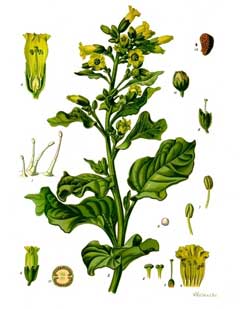 |
|
http://commons.wikimedia.org/wiki/File:Koeh-226.jpg |
 |
| http://commons.wikimedia.org/wiki/User:Llez |
Translate this page:
Summary
Physical Characteristics

 Nicotiana rustica is a ANNUAL growing to 1.5 m (5ft).
Nicotiana rustica is a ANNUAL growing to 1.5 m (5ft).
See above for USDA hardiness. It is hardy to UK zone 8 and is frost tender. It is in flower from July to September. The species is hermaphrodite (has both male and female organs) and is pollinated by Lepidoptera (Moths & Butterflies).
Suitable for: light (sandy), medium (loamy) and heavy (clay) soils and prefers well-drained soil. Suitable pH: mildly acid, neutral and basic (mildly alkaline) soils. It cannot grow in the shade. It prefers moist soil.
UK Hardiness Map
US Hardiness Map
Synonyms
Plant Habitats
Cultivated Beds;
Edible Uses
References More on Edible Uses
Medicinal Uses
Plants For A Future can not take any responsibility for any adverse effects from the use of plants. Always seek advice from a professional before using a plant medicinally.
Antispasmodic Emetic Narcotic Sedative
All parts of the plant contain nicotine which is a strong narcotic[192]. The leaves are antispasmodic, cathartic, emetic, narcotic and sedative[240, 257]. They are used externally as a poultice and a wash in the treatment of rheumatic swelling, skin diseases and scorpion stings[240].
References More on Medicinal Uses
The Bookshop: Edible Plant Books
Our Latest books on Perennial Plants For Food Forests and Permaculture Gardens in paperback or digital formats.

Edible Tropical Plants
Food Forest Plants for Hotter Conditions: 250+ Plants For Tropical Food Forests & Permaculture Gardens.
More

Edible Temperate Plants
Plants for Your Food Forest: 500 Plants for Temperate Food Forests & Permaculture Gardens.
More

More Books
PFAF have eight books available in paperback and digital formats. Browse the shop for more information.
Shop Now
Other Uses
Insecticide
All parts of the plant contain nicotine, this has been extracted and used as an insecticide. The dried leaves can also be used, they remain effective for 6 months after drying[169]. The leaves have also been dried and then chewed as a stimulant or made into snuff for sniffing, or smoked. This species is more potent than N. tabacum (the species normally cultivated for cigarettes). Dynamic accumulator.
Special Uses
Dynamic accumulator
References More on Other Uses
Cultivation details
Prefers a well-drained deep rich moist soil in a sunny position[1, 200]. This plant was formerly cultivated for its use as an insecticide but it has now been largely replaced by N. tabacum[46, 50, 200]. Plants require more than 14 hours daylight per day in order to induce flowering[169].
References Carbon Farming Information and Carbon Sequestration Information
Temperature Converter
Type a value in the Celsius field to convert the value to Fahrenheit:
Fahrenheit:
The PFAF Bookshop
Plants For A Future have a number of books available in paperback and digital form. Book titles include Edible Plants, Edible Perennials, Edible Trees,Edible Shrubs, Woodland Gardening, and Temperate Food Forest Plants. Our new book is Food Forest Plants For Hotter Conditions (Tropical and Sub-Tropical).
Shop Now
Plant Propagation
Seed - surface sow in a warm greenhouse about 10 weeks before the last expected spring frosts. The seed usually germinates in 10 - 20 days at 20°c. Keep the soil moist and pot up as soon as the plants are big enough to handle, planting them out after the last expected frosts.
Other Names
If available other names are mentioned here
Native Plant Search
Search over 900 plants ideal for food forests and permaculture gardens. Filter to search native plants to your area. The plants selected are the plants in our book 'Plants For Your Food Forest: 500 Plants for Temperate Food Forests and Permaculture Gardens, as well as plants chosen for our forthcoming related books for Tropical/Hot Wet Climates and Mediterranean/Hot Dry Climates. Native Plant Search
Found In
Countries where the plant has been found are listed here if the information is available
Weed Potential
Right plant wrong place. We are currently updating this section.
Please note that a plant may be invasive in one area but may not in your area so it’s worth checking.
Conservation Status
IUCN Red List of Threatened Plants Status :

Growth: S = slow M = medium F = fast. Soil: L = light (sandy) M = medium H = heavy (clay). pH: A = acid N = neutral B = basic (alkaline). Shade: F = full shade S = semi-shade N = no shade. Moisture: D = dry M = Moist We = wet Wa = water.

Expert comment
Author
L.
Botanical References
200
Links / References
For a list of references used on this page please go here
Readers comment